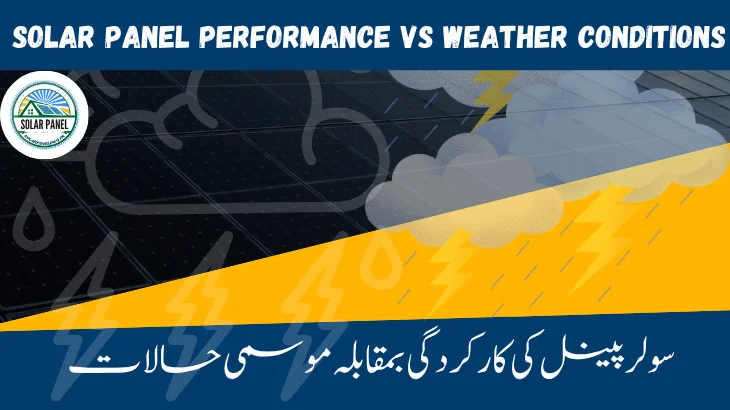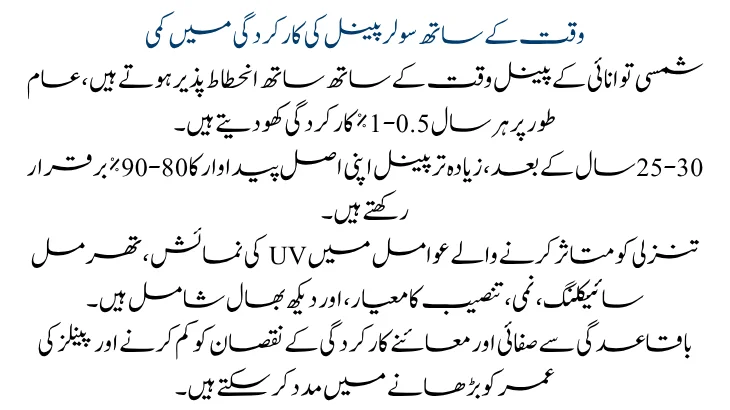Solar Panel Performance vs Weather Conditions
Solar energy is a vital renewable resource, with solar panels converting sunlight into electricity. Various weather conditions, including temperature, sunlight availability, and extreme weather events, influence their efficiency. Understanding these factors is important for optimizing energy production and ensuring reliable solar installations for homeowners, businesses, and installers. The article discusses how different weather conditions, seasonal changes, and environmental factors affect solar panel performance.
Read Also: Performance and Reliability Analysis of Inverters

شمسی توانائی ایک اہم قابل تجدید وسیلہ ہے، جس میں شمسی پینل سورج کی روشنی کو بجلی میں تبدیل کرتے ہیں۔ مختلف موسمی حالات، بشمول درجہ حرارت، سورج کی روشنی کی دستیابی، اور انتہائی موسمی واقعات ان کی کارکردگی کو متاثر کرتے ہیں۔ ان عوامل کو سمجھنا توانائی کی پیداوار کو بہتر بنانے اور گھر کے مالکان، کاروباروں اور انسٹالرز کے لیے قابل اعتماد شمسی تنصیبات کو یقینی بنانے کے لیے اہم ہے۔ مضمون میں بحث کی گئی ہے کہ کس طرح مختلف موسمی حالات، موسمی تبدیلیاں، اور ماحولیاتی عوامل شمسی پینل کی کارکردگی کو متاثر کرتے ہیں۔
Solar Panels Performance Ratio (PR)
The Performance Ratio (PR) is a crucial metric for assessing the real-world efficiency of solar energy systems. It quantifies the ratio of actual energy output to the theoretical maximum output under ideal conditions, factoring in losses due to shading, temperature variations, wiring inefficiencies, and inverter performance.
- Typical PR values for well-designed solar systems range from 75% to 90%.
- Understanding the importance of PR is essential for several reasons: it aids in predicting long-term energy yields, enables comparisons between different solar installations, and helps identify systems that may be underperforming.
By consistently monitoring the PR, potential issues can be detected early, such as dirt buildup on panels, shading obstacles, or problems with inverter functionality.
Solar Panels Performance in Winter
Winter brings distinct challenges for solar panels, including shorter daylight hours, lower sun angles, and the possibility of snow coverage. Despite these conditions, solar panels continue to generate electricity during the winter months, often exhibiting surprising levels of efficiency due to cooler temperatures.
Key Points
- Sunlight Availability: The reduction in daylight hours and lower sun intensity can lead to decreased energy output from solar panels.
- Snow Coverage: While snow can temporarily cover the panels and obstruct sunlight, angled installations can facilitate the snow sliding off, minimizing interruptions in energy generation.
- Temperature Effect: The cold temperatures of winter can enhance the efficiency of photovoltaic (PV) cells, as they tend to perform better in cooler conditions.
Overall, winter conditions do not halt solar energy production, and the technology remains effective even during the colder months.
How Winter Affects Solar Panel Output
Several factors affect the energy production of solar panels in winter:
- Shorter daylight hours reduce total energy output.
- A lower sun angle results in less direct sunlight on the panels.
- Snow coverage can block panels, though angled installations may allow snow to slide off.
- Cold temperatures can improve panel efficiency, as they perform better in cooler conditions.
Solar Panel Efficiency in Winter vs Summer
Solar panels operate year-round, with efficiency varying by season.
- Temperature Effects: Cooler temperatures enhance solar panel efficiency, whereas high temperatures reduce it due to increased electrical resistance.
- Daylight and Sun Angle: Winter has shorter days and a lower sun angle, leading to less sunlight. In contrast, summer has longer days and a higher sun angle, increasing energy production.
- Snow and Weather: In winter, snow can block panels but also reflects sunlight, improving output once it melts. Summer’s clear days maximize production, although extreme heat may slightly decrease efficiency.
Winter vs Summer Efficiency
| Factor | Winter | Summer |
| Daylight Hours | Shorter, less total sunlight | Longer, more sunlight |
| Sun Angle | Lower, less direct sunlight | Higher, more direct sunlight |
| Temperature | Cold (improves efficiency) | Hot (slightly reduces efficiency) |
| Weather Effects | Snow may block, clouds reduce sunlight | Usually clear, optimal conditions |
| Overall Energy Output | Lower due to shorter days | Higher due to longer sunny hours |
Solar panels function in winter, often performing well on cold, sunny days due to increased efficiency in cooler temperatures. However, overall energy output may decline because of shorter daylight hours. Summer offers more energy production due to longer days, despite reduced efficiency in extreme heat. To maximize output throughout the year, it’s important to ensure proper panel tilt, clear snow, and monitor performance.
Do Solar Panels Work in Winter?
- Solar Panels Function in Cold: Solar panels convert sunlight to electricity, not heat, and can be more efficient in cooler temperatures.
- Impact of Winter Conditions: Shorter winter days and the lower angle of the sun result in reduced electricity production, but properly tilted panels can optimize sunlight capture.
- Snow and Ice Effects: Snow can block panels temporarily but often slides off thanks to their tilt, and it can also reflect sunlight, potentially increasing energy production.
- Performance on Cloudy Days: Solar panels can generate electricity even in diffuse light conditions without direct sunlight. Cloud cover impacts their output as follows: with light cloud cover, they produce 70–80% of normal output, while heavy cloud cover results in 20–50% of normal output..
Solar Panels Performance vs Temperature
The performance of solar panels is greatly influenced by temperature:
- Elevated Temperatures: Efficiency decreases due to higher electrical resistance in solar cells, with output potentially declining by 0.3–0.5% for each °C above 25°C.
- Reduced Temperatures: Performance is enhanced, as cooler cells transmit electricity more effectively.
Best Solar Panel Systems for Cloudy Days
- Monocrystalline Panels: High efficiency in indirect light.
- Bifacial Panels: Capture reflected light, enhancing performance.
- Microinverters/Optimizers: Allow independent panel operation to maximize output, especially when shaded.
Recommended Brands
- Maxeon (Maxeon 7 series): ~24.1% efficiency, excellent low-light performance.
- Panasonic EverVolt series: ~22.2% efficiency, reliable in challenging light.
- REC Alpha series: Strong low-light specifications and good value.
- LG NeON R series: High efficiency with good build quality for cloudy areas.
Read Also: Monocrystalline Solar Panel Prices in Pakistan
Solar Panel Performance Degradation Over Time
- Solar panels degrade over time, typically losing 0.5–1% of efficiency per year.
- After 25–30 years, most panels retain 80–90% of their original output.

- Factors influencing degradation include UV exposure, thermal cycling, humidity, installation quality, and maintenance.
- Regular cleaning and inspections can help minimize performance loss and extend the lifespan of the panels.
Rain, Snow, Wind, Hail & Extreme Weather Events
Solar panels can handle typical weather but may be affected by extreme events:
- Rain: Reduces sunlight but cleans panels for better performance afterward.
- Snow: Can block panels, though angled installations promote sliding off; clear days after snow are efficient.
- Wind: Moderate winds enhance efficiency, but extreme winds need secure mounting to avoid damage.
- Hail: Quality panels resist hail, but large hail can cause damage.
- Other Extreme Events: Hurricanes, tornadoes, and heavy storms may require reinforced mounting or insurance.
Tips to Maximize Winter Solar Performance
- Clear Snow from Panels: Accumulated snow can obstruct sunlight; installing panels at an angle helps them shed snow naturally.
- Prune Surrounding Trees: With the winter sun positioned lower in the sky, nearby shade can greatly diminish energy output.
- Consistent Cleaning: While rain and snow typically wash panels, periodic maintenance guarantees optimal efficiency.
- Track Performance: Utilize solar monitoring applications to oversee system performance and identify any potential problems.
Conclusion
Solar panels serve as a dependable and effective renewable energy source year-round, regardless of weather and seasonal changes. Various elements, such as temperature, sunlight exposure, snow, rain, and cloudiness, can affect their performance, but contemporary solar technology—like monocrystalline panels, bifacial models, and microinverters—ensures energy generation even under difficult conditions. By comprehending these factors, performing regular maintenance, and optimizing installation, both homeowners and businesses can enhance energy output, prolong the lifespan of the panels, and experience reliable solar advantages in any weather.
شمسی پینل موسم اور موسمی تبدیلیوں سے قطع نظر سال بھر قابلِ اعتبار اور موثر قابل تجدید توانائی کے ذریعہ کے طور پر کام کرتے ہیں۔ مختلف عناصر، جیسے درجہ حرارت، سورج کی روشنی کی نمائش، برف، بارش، اور بادل ان کی کارکردگی کو متاثر کر سکتے ہیں، لیکن عصری شمسی ٹیکنالوجی — جیسے مونوکریسٹل لائن پینلز، بائی فیشل ماڈلز، اور مائیکرو انورٹرز — مشکل حالات میں بھی توانائی کی پیداوار کو یقینی بناتی ہے۔ ان عوامل کو سمجھنے، باقاعدگی سے دیکھ بھال کرنے، اور تنصیب کو بہتر بنانے سے، گھر کے مالکان اور کاروبار دونوں توانائی کی پیداوار کو بڑھا سکتے ہیں، پینلز کی عمر کو طول دے سکتے ہیں، اور کسی بھی موسم میں قابل اعتماد شمسی فوائد کا تجربہ کر سکتے ہیں۔
FAQ’s
Do solar panels work in winter?
Yes, solar panels work in winter. Cooler temperatures can improve efficiency, though shorter daylight hours may reduce total energy output.
How do cloudy days affect solar panel performance?
Panels can still generate electricity on cloudy days. Light clouds may allow 70–80% of normal output, while heavy clouds reduce output to 20–50%.
How long do solar panels last before performance degrades?
Solar panels typically lose about 0.5–1% of their efficiency each year, maintaining 80–90% of their output after 25–30 years.
